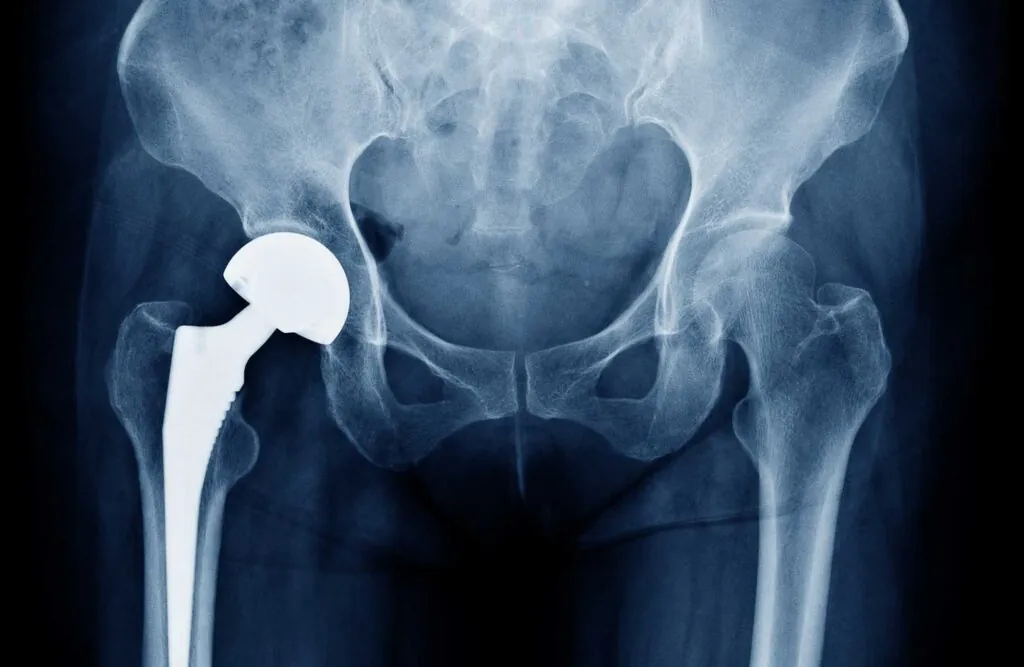A total hip replacement, or total hip arthroplasty (THA), is a surgical procedure that removes damaged bone and cartilage from the hip joint and replaces them with artificial components. It’s a very successful orthopedic surgery for restoring function and reducing pain. In the United States, the number of total hip replacements is expected to increase by 71% to more than 635,000 surgeries per year by 2030.
In this blog, we’ll cover the main reasons people undergo hip replacement, the different surgical approaches, what to expect in recovery, and how physical therapy plays a key role in getting back to the activities you love.
When is a Hip Replacement Needed? Common Causes & Risk Factors
The most common reason for a total hip replacement is osteoarthritis (OA), which is responsible for about 90% of elective cases. OA occurs when the protective cartilage in the joint wears down, causing pain, stiffness, and loss of mobility. Risk factors include aging, prior injury, genetics, and metabolic conditions.
Less common reasons for hip replacement include:
- Avascular necrosis (osteonecrosis)
- Hip fractures
- Developmental dysplasia of the hip
- Failed internal fixation or prior hip surgeries
Types of Hip Replacements
When it comes to replacing the hip joint, surgeons have a few different options. The main distinction is whether both parts of the joint are replaced or just one.
Full (Total) Hip Replacement – Both the acetabulum (hip socket) and the femoral head (ball) are replaced with prosthetic components.
Partial (Hemi) Hip Replacement – Only the femoral head is replaced, usually in fracture cases where the socket remains intact.
Surgical Approaches to Hip Replacement
Surgeons can access the hip joint through several well-established techniques:
Anterior Approach – The incision is made at the front of the hip, working between muscle rather than cutting through them. This technique spares the glutes deep hip rotators. It can be technically more challenging for the surgeon due to limited visibility but usually enables faster early mobility. It has been becoming a more popular approach, though it still requires specialized training and equipment.
Posterior Approach – The most frequently performed approach globally. The incision is made at the back of the hip, moving through or detaching hip muscles to access the joint. It offers excellent surgical visibility and flexibility for implant positioning. This approach often leads to slower initial rehab considerations due to the need for healing of the hip muscles.
Lateral (Anterolateral) Approach – The incision is placed along the outer side of the hip. Some portions of the hip abductor muscles may be split or detached to access the joint, which can affect initial rehab progressions and hip strength. It provides good exposure for and is a moderately common approach.
Recovery After Surgery

Most people can go home the same day or within 1–2 days after a hip replacement. Early mobilization is common, as patients often walk with assistance within hours of surgery. Success rates are high, with most individuals reporting significant pain reduction and improved quality of life.
Rehab Progressions & Precautions
Surgical approach can influence early rehab timelines. For example, the anterior approach typically allows quicker return to basic activities due to muscle-sparing techniques. However, long-term outcomes are generally similar across all approaches when rehabilitation is well-managed.
Hip Precautions
Precautions are specific movement restrictions given after surgery and are traditionally prescribed to reduce the risk of dislocation. Common precautions include initially avoiding certain movements like crossing your legs or bending down past 90 degrees. However, research has questioned their universal use:
A recent study found no significant difference in dislocation rates between patients given precautions and those without, particularly after anterior or lateral approaches. Other factors including BMI, prosthetic fit, and surgeon experience also strongly influence dislocation risk—not just movement alone.
Many physical therapists and researchers are now questioning the use of blanket precautions, noting that they may slow recovery, increase fear of movement, and contribute to post-operative deconditioning.
Discuss precautions with your surgeon and physical therapist. Individualized guidelines tailored to your surgical approach, health status, and goals are often more effective than one-size-fits-all restrictions.
How a Physical Therapist Can Help with Hip Replacement Recovery

Physical therapists are the movement and recovery specialists after a hip replacement. Their role includes:
- Designing an individualized exercise program – targeting strength, range of motion, balance, and gait mechanics.
- Monitoring progress and safety – adjusting exercises to match your healing phase and abilities.
- Pain and swelling management – using modalities, positioning, and activity pacing.
- Functional training – helping you safely navigate stairs, get in and out of cars, or return to recreational activities.
- Addressing whole-body conditioning – maintaining overall strength and cardiovascular fitness to prevent further deconditioning
An evidence-based PT approach considers your current ability, pre-surgery function, and personal goals. Early, progressive loading within safe boundaries can accelerate recovery and improve long-term outcomes.
Start Physical Therapy for the Best Hip Replacement Outcomes
Total hip replacement can be a life-changing surgery for many people with advanced hip pain and loss of function. While surgical technique and implant choice are important, rehabilitation is the key driver of long-term function. The latest evidence points to early and individualized rehab being the key to the best long-term outcomes.
Find a PT Clinic Near You!
If you’ve previously had a hip replacement or are planning one in the future, seeking treatment from a qualified physical therapist is essential for adequate recovery. Regular sessions with a physical therapist can significantly improve your mobility, reduce pain, and enhance your overall quality of life. Take the first step towards recovery by finding a physical therapy location near you. Early intervention can lead to quicker and more effective relief, allowing you to return to normal activities and get back to what you love.


